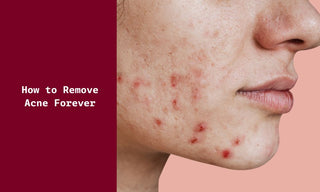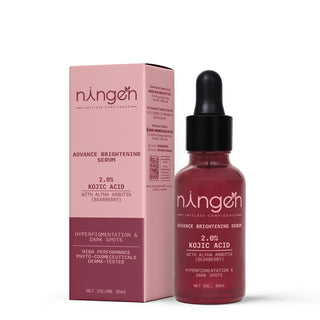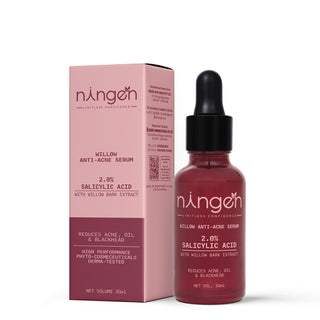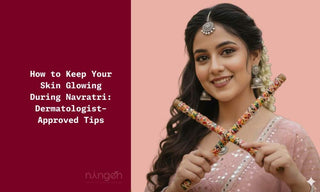एक्ने आज - कल आम सी बात है, ये काफी फस्ट्रेटिंग हो सकते है। ये आपके आत्म - विश्वास में भी कमी ला सकते है, और कभी कभी तो ऐसा लगता है की की ये कभी ख़त्म ही नहीं होंगे। चाहे वह जिद्दी ब्रेकआउट्स हो, लाल फुंसी हो या फिर जो दाग-धब्बे पीछे रह जाते हैं, एक्ने आपकी त्वचा के साथ-साथ आत्मविश्वास पर भी असर डालता है। क्या आप भी ऐसी ही समस्या का सामना कर रहे हैं? अगर आपने ढेर सारी क्रीम्स और इलाज़ आज़माए हैं, फिर भी कोई असर नहीं हुआ, तो जानिए कि आप अकेले नहीं हैं ! सच बात यह है कि एक्ने को सही तरीके से मैनेज करने और उसे दूर करने के कई प्रभावी उपाय मौजूद हैं। इस ब्लॉग में हम आपको 5 आसान और असरदार टिप्स देने जा रहे हैं, जिनकी मदद से आप एक्ने से छुटकारा पा सकते हैं और हमेशा के लिए स्वस्थ त्वचा पा सकते हैं। तो चलिए, शुरू करते हैं!
In This Article;
- क्या है एक्ने?
- अलग - अलग एक्ने
- एक्ने कैसे बनता है?
- एक्ने को कम करने के 5 प्रभावी टिप्स
- एक्ने और दाग-धब्बों को रोकने के लिए स्किनकेयर सामग्री
- एक्ने के लिए कब डॉक्टर से मदद लें?
- अंतिम विचार
- संक्षेप में:
- अक्सर पूछे जाने वाले सवाल
क्या है एक्ने?
एक्ने एक सामान्य त्वचा समस्या है, जो चेहरे, गर्दन, छाती और पीठ पर पिंपल्स, ब्लैकहेड्स और व्हाइटहेड्स का कारण बनती है। यह तब होता है जब बालों के रोम (फॉलिकल्स) तेल और मृत त्वचा द्वारा अवरुद्ध हो जाते हैं, जिससे धब्बे और सूजन होती है। एक्ने हल्का या गंभीर हो सकता है और यह व्यक्ति को असहज या व्यक्ति का आत्मविश्वासी गिरा सकता है।
हॉर्मोन, आहार, आनुवंशिकी, तनाव और कुछ दवाइयां एक्ने को प्रभावित कर सकती हैं। बैक्टीरिया, विशेष रूप से प्रोपियोनिबैक्टीरियम एक्ने (Propionibacterium acnes) जब बंद पोर्स में इन्फेक्शन करता है, तो सूजन, रेडनेस और मवाद पैदा कर सकता है। यदि इलाज न किया जाए, तो गंभीर एक्ने से काले धब्बे या दाग पड़ सकते हैं। जबकि तैलीय त्वचा वाले लोग एक्ने के प्रति अधिक संवेदनशील होते हैं, सूखी और संवेदनशील त्वचा भी प्रभावित हो सकती है। नियमित सफाई और सही स्किनकेयर से सीबम और मृत त्वचा के जमा होने को नियंत्रित किया जा सकता है, और एक्ने को भी हटाया जा सकता है।
अलग - अलग एक्ने
हमारी स्किन टाइप की तरह ही हमारे एक्ने भी अलग - अलग टाइप के होते है , जो हल्के से लेकर गंभीर तक हो सकते हैं, और हर प्रकार की त्वचा पर अलग तरीके से असर डालता है। इन टाइप्स को समझना एक्ने को सही तरीके से मैनेज और ट्रीट करने में मदद करता है। यहाँ कुछ सबसे सामान्य प्रकार दिए गए हैं :
1. व्हाइटहेड्स (क्लोज़्ड कोमेडोन्स):
व्हाइटहेड्स तब बनते हैं जब एक पोअर तेल और मृत त्वचा (डेड स्किन )से अवरुद्ध हो जाता है और सतह पर बंद रहता है। यह छोटे, मांस के रंग के बम्प्स के रूप में दिखाई देते हैं जो त्वचा के नीचे होते हैं।
2. ब्लैकहेड्स (ओपन कोमेडोन्स):
ब्लैकहेड्स तब होते हैं जब एक अवरुद्ध पोअर सतह पर खुला रहता है और हवा के संपर्क में आने से काला हो जाता है। ये छोटे, काले धब्बे होते हैं जो अक्सर नाक, ठुड्डी और माथे पर दिखाई देते हैं।
3. पेप्यूल्स:
पेप्यूल्स छोटे, लाल रंग के सूजन वाले बम्प्स होते हैं जो त्वचा पर दिखाई देते हैं। ये तब बनते हैं जब बालों के रोम के आसपास की दीवारें टूट जाती हैं, जिससे सूजन होती है। पेप्यूल्स में मवाद नहीं होता और ये हाथ से छूने पर कोमल महसूस हो सकते हैं।
4. पस्च्यूल्स:
पस्च्यूल्स पेप्यूल्स के समान होते हैं लेकिन इनमें मवाद होता है, जो लाल बम्प्स के रूप में दिखाई देते हैं जिनके केंद्र में सफेद या पीला रंग होता है। ये पारंपरिक पिंपल्स की तरह दिखते हैं और संवेदनशील या दर्दनाक हो सकते हैं।
5. नोड्यूल्स:
नोड्यूल्स बड़े, कठोर और दर्दनाक गांठ होते हैं जो त्वचा की गहराई में बनते हैं। ये तब बनते हैं जब अवरुद्ध पोअर गंभीर रूप से संक्रमित हो जाते हैं, जिससे गहरी सूजन होती है। नोड्यूल्स लंबे समय तक रहते हैं और इन्हें आमतौर पर उपचार की आवश्यकता होती है।
6. सिस्ट्स:
सिस्टिक एक्ने सबसे गंभीर रूप है, जिसमें बड़ी, मवाद से भरी सिस्ट्स बनती हैं जो त्वचा के भीतर गहराई से विकसित होती हैं। ये दर्दनाक होती हैं, दाग छोड़ सकती हैं और इन्हें ठीक से इलाज के लिए चिकित्सा सहायता की आवश्यकता होती है।
7. फंगल एक्ने :
फंगल एक्ने बालों के रोम में यीस्ट के अत्यधिक बढ़ने के कारण होता है। यह छोटे, खुजलीदार पिंपल्स की तरह दिखता है और अक्सर बैक्टीरियल एक्ने से भ्रमित हो जाता है। इस प्रकार के एक्ने के लिए सामान्य एक्ने उत्पादों के बजाय एंटीफंगल इलाज की आवश्यकता होती है।
एक्ने के हर प्रकार के लिए अलग-अलग उपचार की आवश्यकता हो सकती है, इसलिए यह समझना कि आप किस प्रकार के एक्ने से जूझ रहे हैं, इसे प्रभावी रूप से हटाने में मदद करता है। सही समाधान के लिए एक त्वचा विशेषज्ञ से सलाह लेना भी फायदेमंद हो सकता है।
एक्ने कैसे बनता है?
एक्ने एक सामान्य त्वचा समस्या है जो ज्यादातर लोगों को होती है। यह तब होता है जब बालों के रोम (हैर फॉलिकल्स) तेल (सीबम) और मृत त्वचा की कोशिकाओं से बंद हो जाते हैं। हमारी त्वचा में तेल ग्रंथियाँ होती हैं जो सीबम बनाती हैं, जो त्वचा को चिकना और स्वस्थ रखने के लिए जरूरी है। लेकिन जब ये ग्रंथियाँ ज्यादा तेल बनाती हैं, तो त्वचा तैलीय हो जाती है और पोर्स (छिद्र) बंद हो जाते हैं।
जब पोर्स बंद हो जाते हैं, तो बैक्टीरिया, खासकर प्रोपियोनिबैक्टीरियम एक्ने (P. acnes), उसमें बढ़ने लगते हैं, जिससे सूजन होती है और पिंपल्स, ब्लैकहेड्स, व्हाइटहेड्स, सिस्ट्स या नोड्यूल्स जैसे दाने बनते हैं।
एक्ने के बनने के कई कारण हो सकते हैं। इसे नियंत्रित करने के लिए यह जानना जरूरी है कि एक्ने को क्या ट्रिगर करता है।
1. हॉर्मोनल बदलाव:
हॉर्मोनल बदलाव, जैसे प्यूबर्टी, पीरियड्स, गर्भावस्था या PCOS, सीबम उत्पादन बढ़ाते हैं, जिससे पोर्स बंद हो सकते हैं और एक्ने हो सकता है।
2. आहार:
जो लोग ज्यादा चीनी, डेयरी या जंक फूड खाते हैं, उन्हें एक्ने हो सकता है। इनसे शरीर में तेल बढ़ता है।
3. तनाव:
तनाव से शरीर में हॉर्मोन बदलते हैं, जिससे तेल ज्यादा बनता है और ब्रेकआउट्स बढ़ सकते हैं।
4. स्किनकेयर उत्पाद:
जो स्किनकेयर प्रोडक्ट्स पोर्स को बंद करते हैं या त्वचा को जलाते हैं, वे भी एक्ने का कारण बन सकते हैं।
5. दवाइयां:
कुछ दवाइयां, जैसे स्टेरॉयड्स और लिथियम, एक्ने को बढ़ा सकती हैं।
6. जीन:
अगर परिवार में किसी को एक्ने है, तो आपको भी होने का खतरा ज्यादा होता है।
7. पर्यावरण:
प्रदूषण, नमी और पसीना भी पोर्स को बंद कर सकते हैं और एक्ने का कारण बन सकते हैं।
8. चेहरे को छूना:
बार-बार चेहरे को छूने से गंदगी और बैक्टीरिया त्वचा पर आ जाते हैं, जिससे ब्रेकआउट्स हो सकते हैं।
एक्ने को कम करने के 5 प्रभावी टिप्स
1. सही सफाई:
हर दिन 2 बार हलके क्लेंज़र से अपने चेहरे को धोएं ताकि अतिरिक्त तेल और गंदगी हट जाए।
2. मुलायम एक्सफोलिएशन:
सप्ताह में 2-3 बार हलके एक्सफोलिएटर्स का इस्तेमाल करें ताकि त्वचा के मृत कोशिकाएं हट जाएं।
3. एक्ने -लड़ाई वाले उपचार:
सलिसिलिक एसिड या बेंजोइल पेरोक्साइड जैसे प्रोडक्ट्स का उपयोग करें, जो तेल उत्पादन कम करते हैं और बैक्टीरिया से लड़ते हैं।
4. स्वस्थ आहार:
चीनी और डेयरी कम खाएं, और फलों और सब्जियों का सेवन करें जो त्वचा को साफ रखते हैं।
5. हाइड्रेशन और मॉइश्चराइजिंग:
पानी पीते रहें और सूखी त्वचा के लिए हल्का, तेल-मुक्त मॉइश्चराइज़र इस्तेमाल करें।
एक्ने और दाग-धब्बों को रोकने के लिए स्किनकेयर सामग्री
1. सलिसिलिक एसिड:
यह पोर्स को साफ करता है और त्वचा की मृत कोशिकाओं को हटाता है, जिससे एक्ने कम होता है।
2. बेंजोइल पेरोक्साइड:
यह बैक्टीरिया को मारता है और सूजन को कम करता है, जिससे पिंपल्स ठीक होते हैं।
3. नायसिनामाइड (विटामिन B3):
यह सूजन कम करता है, और तेल उत्पादन को नियंत्रित करता है, जिससे दाग हल्के होते हैं।
4. रेटिनॉयड्स (रेटिनॉल):
यह त्वचा को नया बनाने में मदद करता है और एक्ने के दाग को कम करता है।
5. टी ट्री ऑयल:
यह एक प्राकृतिक एंटीमाइक्रोबियल है, जो बैक्टीरिया को कम करता है और त्वचा को शांत करता है।
एक्ने के लिए कब डॉक्टर से मदद लें?
1. गंभीर या लगातार ब्रेकआउट्स:
अगर आपका एक्ने दर्दनाक या फैला हुआ है, या घरेलू उपायों से ठीक नहीं हो रहा है, तो डॉक्टर से मिलें।
2. सिस्टिक या नोड्यूलर एक्ने :
अगर बड़े, दर्दनाक दाने हैं, तो डॉक्टर से मदद लें क्योंकि इनसे दाग पड़ सकते हैं।
3. दाग और काले धब्बे:
अगर एक्ने के कारण त्वचा पर दाग हैं, तो डॉक्टर से उचित उपचार प्राप्त करें।
4. मानसिक प्रभाव:
अगर एक्ने आपकी आत्म-विश्वास को प्रभावित कर रहा है, तो एक डॉक्टर आपकी मदद कर सकता है।
5. संक्रमण या त्वचा में जलन:
अगर त्वचा में अत्यधिक जलन या सूजन हो रही हो, तो इसे और बढ़ने से रोकने के लिए डॉक्टर से संपर्क करें।
जब ओवर-द-काउंटर इलाज काम नहीं करते
अगर आपने कई ओवर-द-काउंटर (खुद से खरीदी जाने वाली) उत्पादों का इस्तेमाल किया है, और फिर भी कोई फर्क नहीं पड़ा, तो एक डॉक्टर (त्वचा विशेषज्ञ) आपको और मजबूत दवाइयाँ दे सकता है, जो आपके त्वचा के अनुसार असरदार हो सकती हैं।
हॉर्मोनल एक्ने
कुछ महिलाओं को हॉर्मोनल बदलाव के कारण एक्ने होता है, खासकर ठुड्डी और चेहरे के नीचे के हिस्से में। ऐसे मामलों में हॉर्मोनल दवाइयाँ जैसे जन्म नियंत्रण गोलियाँ, स्पाइरोनोलैक्टोन, या अन्य उपचार मदद कर सकते हैं।
अंतिम विचार
एक्ने एक सामान्य त्वचा समस्या है, जो हर उम्र के लोगों को हो सकती है। लेकिन अगर आप सही जानकारी और सही तरीका अपनाते हैं, तो इसे आसानी से कम किया जा सकता है। एक्ने के प्रकार को समझकर, सही स्किनकेयर रूटीन अपनाकर, और डॉक्टर की सलाह लेकर आप साफ और स्वस्थ त्वचा पा सकते हैं।
एक्ने को पूरी तरह खत्म करना मुश्किल हो सकता है, लेकिन अगर आप नियमित रूप से सही उत्पादों का उपयोग करें, तो आप इसके असर को बहुत हद तक कम कर सकते हैं। याद रखें, धैर्य रखें और अपनी त्वचा के लिए सबसे उपयुक्त तरीका ढूंढें।
संक्षेप में
एक्ने तब होता है जब बालों के रोम में तेल और मृत त्वचा जमा हो जाते हैं। एक्ने के कई प्रकार होते हैं, जैसे ब्लैकहेड्स, व्हाइटहेड्स, पिंपल्स, सिस्ट्स, और नोड्यूल्स। हॉर्मोनल बदलाव, आहार, तनाव और जीन प्रमुख कारण होते हैं। एक्ने को कम करने के लिए सही सफाई, हलका एक्सफोलिएशन, और सलिसिलिक एसिड जैसे उत्पादों का उपयोग करें। अगर एक्ने गंभीर हो, तो डॉक्टर से मदद लें।
अक्सर पूछे जाने वाले सवाल
Q1. एक्ने क्यों होता है?
एक्ने तब होता है जब बालों के रोम तेल और मृत त्वचा से बंद हो जाते हैं, जिससे ब्लैकहेड्स, व्हाइटहेड्स, पिंपल्स और सिस्ट्स बनते हैं।
Q2. क्या एक्ने हमेशा के लिए खत्म किया जा सकता है?
एक्ने पूरी तरह से खत्म नहीं हो सकता, लेकिन सही देखभाल से आप ब्रेकआउट्स को कम कर सकते हैं।
Q3. एक्ने को ठीक करने के लिए कौन से सबसे अच्छे उत्पाद हैं?
नायसिनामाइड, सलिसिलिक एसिड, बेंजोयल पेरोक्साइड, रेटिनॉयड्स, और टी-ट्री ऑयल जैसे उत्पाद एक्ने को ठीक करने में मदद करते हैं।
Q4. मैं 3 दिनों में अपने पिंपल्स को कैसे कम कर सकता हूँ?
- बेंजोयल पेरोक्साइड या सलिसिलिक एसिड वाले उत्पाद का इस्तेमाल करें।
- मिट्टी का मास्क लगाएं, जो तेल और गंदगी को बाहर निकाले।
- त्वचा को हाइड्रेट रखें और माइल्ड मॉइश्चराइज़र लगाएं।
- त्वचा को न छुएं या न दबाएं।
Q5. क्या मेरा आहार एक्ने का कारण बन रहा है?
कुछ खाद्य पदार्थ, जैसे चीनी, डेयरी, और तले-भुने खाने से कुछ लोगों में एक्ने हो सकता है।
Q6. क्या तनाव से एक्ने और बढ़ता है?
जी हां, तनाव से तेल उत्पादन बढ़ सकता है, जिससे पिंपल्स और अधिक हो सकते हैं। तनाव कम करने के लिए रिलैक्सेशन तकनीकें अपनाएं।
Q7. मुझे डॉक्टर से कब मिलना चाहिए?
अगर ओवर-द-काउंटर इलाज से कोई फर्क नहीं पड़ रहा, या आपके पिंपल्स बहुत दर्दनाक हैं, तो डॉक्टर से मिलें।
Q8. ब्लैकहेड्स और व्हाइटहेड्स में क्या अंतर है?
ब्लैकहेड्स खुले पोर्स होते हैं, जो हवा से काले हो जाते हैं, जबकि व्हाइटहेड्स बंद पोर्स होते हैं जो त्वचा के नीचे रहते हैं।
Q9. क्या तैलीय त्वचा को नियंत्रित किया जा सकता है?
जी हां, तैलीय त्वचा को सही उत्पादों के इस्तेमाल और नियमित सफाई से नियंत्रित किया जा सकता है।
Q10. इलाज से परिणाम आने में कितना समय लगता है?
एक्ने इलाज से परिणाम दिखने में 4-8 सप्ताह तक लग सकते हैं। नियमित देखभाल से ही अच्छे परिणाम मिल सकते हैं।











